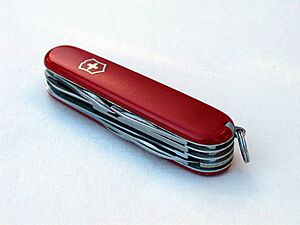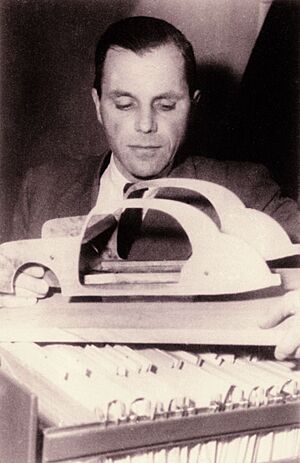Design facts for kids

A design is a plan or idea for something new. It could be an object, a way of doing things, or a whole system. When we talk about "design," we mean something that was made on purpose by someone thinking about it. The word "to design" means the process of creating this plan.
Sometimes, if someone makes something without a detailed plan, like in arts and crafts, it can still be called designing. A good design usually has a clear purpose. It needs to meet certain goals and fit within limits. Designers also think about how things look (aesthetics), how they work (function), how much they cost, their impact on the environment, and how they affect people.
Old examples of designs include drawings for buildings or machines, sewing patterns, and even plans for how a business works.
Contents
Who Designs Things?
People who create designs are called designers. This term usually refers to someone who works in a design field as a job. You might hear about a fashion designer, a product designer, or a web designer. Even architects and engineers are designers!
Designers follow a "design process" to create their work. This can be a quick sketch or a long, complex journey. It might involve lots of research, talking with others, thinking, making models, and changing things many times.
But designing isn't just for professionals. As the scientist Herbert A. Simon said, "Everyone designs who devises courses of action aimed at changing existing situations into preferred ones." This means if you plan how to make something better, you are designing!
A Quick Look at Design History
Studying the history of design can be tricky because "designing" means different things to different people. Many design historians focus on the Industrial Revolution. This is when factories started making many copies of things.
However, some historians also look at older objects made before factories. They see design even in things from ancient times. Design history became its own field of study in the 1970s. Before that, it was often part of art history.
Learning About Design
Schools for design education started in the 1800s. Some early ones include the Norwegian National Academy of Craft and Art Industry (1818) and the Government School of Design in the UK (1837). The German school Bauhaus, started in 1919, had a huge impact on how modern design is taught.
Design education teaches students about the ideas, knowledge, and values behind designing products, services, and environments. It helps them develop skills for designing. Students often work on projects in a studio, like artists do.
Design is also taught in general education, for example, in "Design and Technology" classes. This helps everyone understand how designers think and act.
How Designers Work
There are many ways designers create things. Some see design as solving a problem in a logical way. They might follow steps to find the best solution. Others see it more as a process of trying things, learning from them, and making changes as they go.
Both ways are important. Sometimes, designers follow a clear plan. Other times, they learn and adapt as they create.
Different Ways to Think About Design
Many ideas guide designers. Here are a few important ones:
- Critical design: This approach uses designed objects to make people think about current ideas or problems in society. It can show what a future might look like to get a reaction.
- Ecological design: This focuses on how a product or service affects the environment throughout its entire life. Designers try to make things that are good for the planet.
- Participatory design: This means involving everyone who will use or be affected by a design in the creation process. This helps make sure the final product truly meets their needs. When people work together, they often come up with more creative ideas.
- Scientific design: This uses scientific knowledge to create products. For example, designing face masks might involve studying how well they filter air, how comfortable they are, and if they can break down naturally.
- Service design: This is about designing the whole experience around a product or service. It looks at how people interact with a service, from start to finish, to make it as smooth and helpful as possible.
- Transgenerational design: This means making products and environments easy to use for people of all ages, including those who might have physical or sensory challenges as they get older.
- User-centered design: This puts the needs, wants, and limits of the person who will use the design first. A part of this is ergonomics, which is about designing things to fit the human body comfortably and efficiently.
Design and Art
The line between art and design can be a bit blurry. Many types of design are considered "applied arts." This includes industrial design (like cars or appliances), graphic design (like logos or posters), fashion design, and decorative arts (like crafts).
In areas like photography or illustration, the difference often comes down to why the work was made. Is it for pure artistic expression (fine art) or for a business purpose (commercial art)?
Types of Designing
There are many different fields where design is important:
- Applied arts
- Architecture
- Automotive design
- Communication design
- Costume design
- Engineering design
- Fashion design
- Game design
- Graphic design
- Industrial design
- Interior design
- Landscape architecture
- Product design
- Software design
- Sound design
- Urban design
- Web design
See also
 In Spanish: Diseño para niños
In Spanish: Diseño para niños
|





